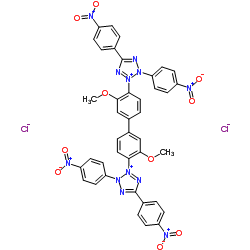Comparison between the chromate inhibition test and a cytochemical method for the determination of glucose-6-phosphate dehydrogenase deficiency in erythrocytes.
G N Jonges, H Hagen, C J Van Noorden, R S Weening, D Roos
文献索引:Clin. Chim. Acta 181(2) , 135-41, (1989)
全文:HTML全文
摘要
The sensitivity and specificity of the chromate inhibition test for the determination of glucose-6-phosphate dehydrogenase (G6PD) deficiency in erythrocytes were compared with a cytochemical staining method. Fifty blood samples were used in a double blind study. The samples were selected from 600 blood samples on the basis of two biochemical criteria, viz. either G6PD activity less than 4.8 IU/g Hb as analysed spectrophotometrically and/or G6PD activity less than glutathione reductase (GSSG-R) activity. The cytochemical assay was taken as reference because it has been proved to be sensitive and specific for the detection of heterozygous and homo/hemizygous forms of deficiency. Cytochemically, one hemizygously deficient patient, 19 heterozygotes and 30 normals were detected. When applying the chromate inhibition test a somewhat different result was obtained with the same samples: one of the 30 normals was classified as heterozygously deficient (3% false positives) and 5 of the 19 heterozygously deficient patients were classified as normal (26% false negatives). It is concluded that the chromate inhibition test is a more sensitive biochemical test than the fluorescence spot test or spectrophotometric assays. However, it is less reliable than the cytochemical test for the detection of heterozygously G6PD deficient patients.
相关化合物
| 结构式 | 名称/CAS号 | 分子式 | 全部文献 |
|---|---|---|---|
 |
四硝基四氮唑蓝(TNBT)
CAS:1184-43-6 |
C40H28Cl2N12O10 |
|
P5-2 of rice black-streaked dwarf virus is a non-structural ...
2015-05-01 [Arch. Virol. 160(5) , 1211-7, (2015)] |
|
Fabrication of mechanically robust, self-cleaning and optica...
2015-08-14 [Nanoscale 7 , 13125-34, (2015)] |
|
Reduced excitability of gp130-deficient nociceptors is assoc...
2014-11-01 [Pflugers Arch. 466(11) , 2153-65, (2014)] |
|
Structure of motor nerve terminals in chickens with heredita...
1985-09-01 [Muscle Nerve 8(7) , 568-75, (1985)] |
|
Quantitative aspects of the histochemical tetrazolium salt r...
1985-06-01 [Histochem. J. 17(6) , 707-15, (1985)] |